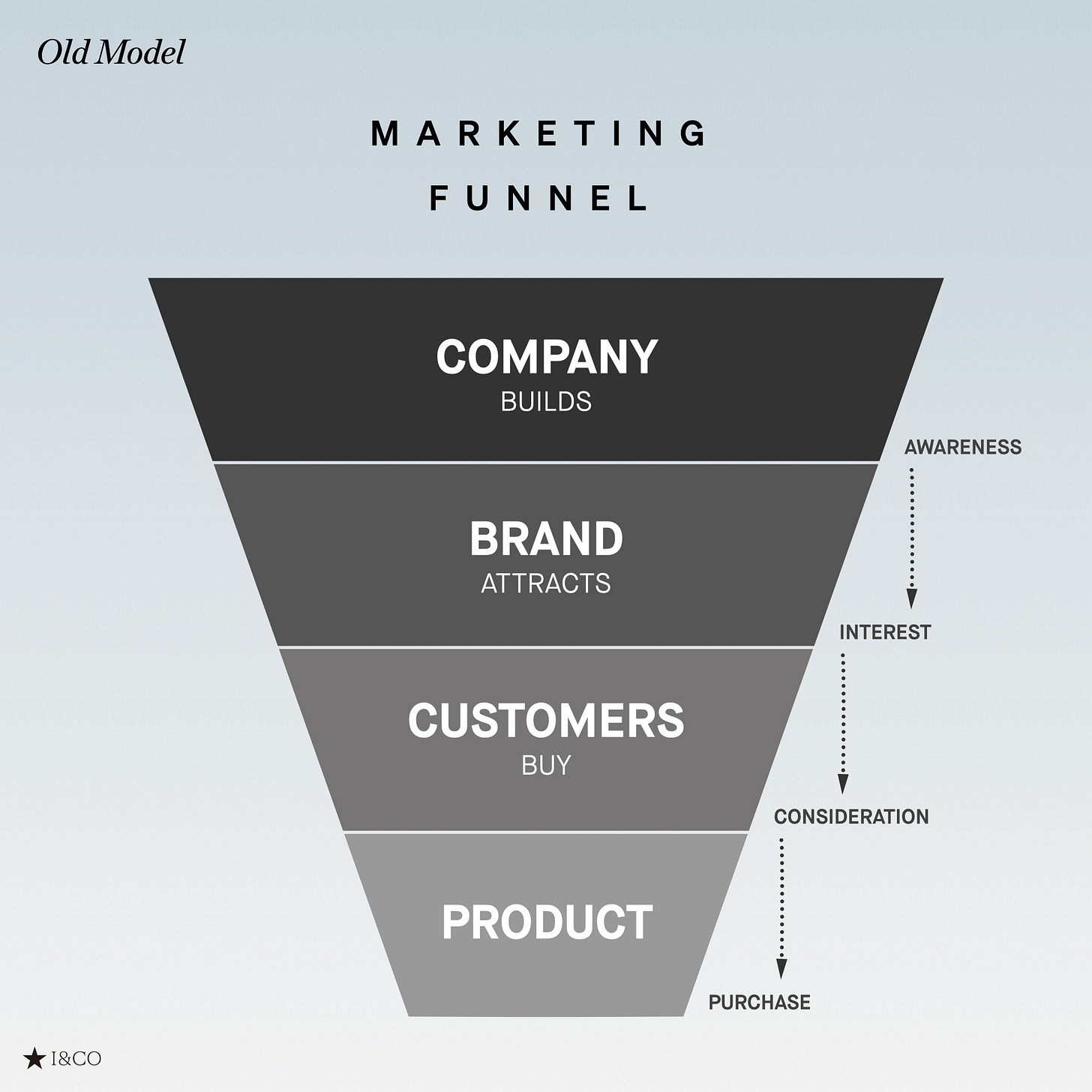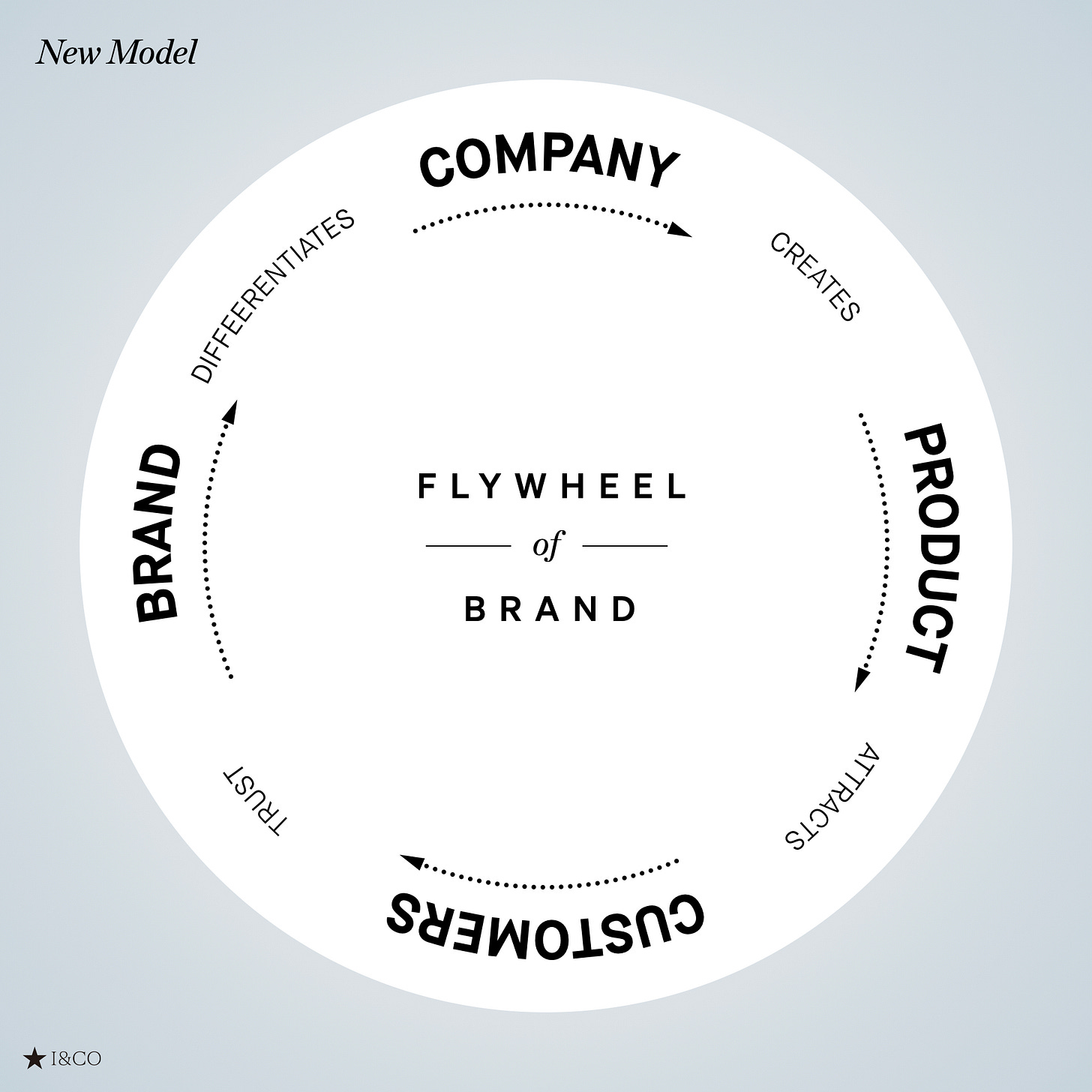From “Funnel” to “Flywheel”
As the rules of marketing change, change the questions you ask to get better results.

The Consumer decides
In early January 2024, there was a sudden increase of Uniqlo’s women’s bra top sales in the US.
This bra top has been popular since its introduction over ten years ago. The product’s simple innovation was that the bras were part of the shirt, so the wearer didn’t need a separate pair, providing comfort and coolness.
These bra tops were thin and light without much insulation, positioned as a summer product. They were available on Uniqlo’s website year-round, but the company didn’t prominently feature them online or in-store during the winter months.
Why the sudden surge in sales after many years AND outside the typical sales cycle?
The cause was customer-driven.
A TikTok user posted a way to style the Uniqlo bra top with another top and yoga bottoms for working out. This combination kept warmth without bulk. It wasn’t intended for a workout, but it was suitable.
The company started to style the product and display the bra top on mannequins at its stores with another top and leggings—an unusual combination in the middle of winter.
This wasn’t the first time Uniqlo or other brands leveraged user-defined functionality to generate demand.
Another well-known story is the 2022 Uniqlo Round Mini Shoulder Bag. The crescent-shaped crossbody bag became popular after a UK TikToker touted its spacious interior. The clip went viral globally, and so did the demand for it. It became so iconic among millennials that it was crowned the “Millennial Birkin.”
Ironically, this feature wasn’t intentional. The designers didn’t make the bag spacious, nor did the marketing team highlight it. Consumers discovered and defined it.
 Tiktok failed to load.
Tiktok failed to load.Enable 3rd party cookies or use another browser
The fact that no one talks about is that the product had been available since 2020. It sat dormant on shelves for two years.
Uniqlo isn’t known for its accessories. Bags are displayed quietly in back areas of stores and don’t get much marketing budget. Unlike most fashion brands, it makes such items not to create a trend but to provide simple solutions to customers’ lives. Uniqlo’s mantras are “Simple Made Better” and “Made for All.”
Four years after its release, it’s still one of the best-selling items on Uniqlo’s website. It has a 4.8/5 rating and over a thousand reviews, significantly more than any other product.
For the bra top and shoulder bag, Uniqlo’s “brand” wasn’t the primary driver of demand. The product elevated it.
The relationship between companies and customers has fundamentally shifted.
Brands telling customers what to think, feel, and believe about their products is no longer an effective marketing strategy.
The Consumer decides.
From “Funnel” to “Flywheel”
Until around 2008, the common marketing framework was the Funnel:
Company builds Brand (Awareness)
Brand attracts Customers (Interest & Consideration)
Customers buy Product (Purchase)
Both Uniqlo examples used this Funnel framework to sell those products. They were neither hits nor flops. Uniqlo mostly sold them to brand-aware customers.
Despite being in the market since 2006, brand awareness in the US is around 29%, and sales were modest. The Marketing Funnel was the primary vehicle for both the bra top and round shoulder bag for multiple years.
Until the Flywheel of Brand kicked in.
The Flywheel of Brand model is as follows:
Company creates Product
Product attracts Customers
Customers trust Brand
Brand differentiates Company
1. Company Creates Product
The emphasis has shifted from marketing-first to product-first thinking. Without product-market fit, no marketing will help.
Product desire may not be apparent initially. The key is how to build that desire into the product. Not easy, I know. See Step 2.
2. Product Attracts Customers
The product can be the most powerful marketing tool when it has a Key Product Moment, a moment or feature that makes the innovation visible, understandable, and most importantly, desirable. Read more in my previous essay.
With Uniqlo’s Round Mini Shoulder Bag, that Key Product Moment was what Caitlin demonstrated: this small bag fits more stuff than you think.
The emphasis of marketing isn’t to create an emotional connection between the Brand and the Customer. It’s to create a relatable narrative about the Product.
3. Customers Trust Brand
As customers interact with distinct products, they develop trust in the brand behind them, built on actual experience rather than marketing promises.
Once the Flywheel started to spin, Uniqlo put more torque by releasing various versions of the bag: more colors, styles, sizes, materials, collabs, etc.
This approach may not work for all brands.
Nike tried a similar approach with Nike Dunks, a product for sneakerheads craving exclusivity. They stopped trusting the brand.
With Uniqlo, the brand narrative is “Made For All.” The Flywheel reinforced this narrative.
4. Brand Differentiates Company
The cycle culminates when the Brand becomes a genuine differentiator for the Company, earned through consistent delivery of excellent Products and experiences.
The Brand becomes a shorthand for Trusted Differentiation. Refer to my essay “Brand New Rules of Marketing.”
This trust builds the brand, feeding into the next cycle of the Flywheel.
Modern brand building lies not in controlling the narrative, but in creating conditions for it to grow and stories to emerge.
The Old Model isn’t as relevant or effective as it used to be. We need to change the way we approach it and the specific questions we ask.
The Marketing Funnel asked, "How do we tell our story?"
Instead, the Flywheel of Brand asks, "How do we create products that reinforce the narrative and create conditions for customers to tell their stories?"
Asking the same questions won’t lead us to a new place. Change the questions you ask.





Great post Rei. thank you for sharing.
This takes me back to the early days of when I joined R/GA. I’d arrived from the storytelling and metaphor obsessed world of advertising to the production obsessed world of R/GA and digital platforms. Took me a short while to join the dots but one observation was the power of a particular type of story - the demonstration. It has the share-abiliity of all stories but also the utility and tangible value that is needed in the (then new) mass medium of platforms. Indeed demos work really well in traditional media funnel as well as the unit of value exchange in a more systemic/ flywheel model of digital platforms. Unlike metaphoric stories (so loved by ad agencies) the demo not only built trust but also drove action (again valuable in the platform world). And ultimately giving people a sense of control/agency that metaphoric ads lacked. Many people confused a tangible demo with emotional metaphor, claiming the decline of emotional advertising but we quickly learned that demonstration and utility can be immensely emotional and brand building. Your flywheel captures this eloquently but I question whether it replaces the funnel of traditional mass medias or is it just a symptom of the dominance of the mass digital platforms today. If AI adoption, ad revenue greed and misinformation corrupt the user experience of the mass digital platforms we might still need the historic funnel for reference. In fact, one might go as far as arguing that Agentic AI translates all the information on the digital platforms and internet into useful demonstrations/instructions for people to act upon.